Didn't the Nazis largely flee to Argentina and Brazil as well? Maybe they learned it from their Confederate friends.
"Rather than accept defeat, up to 20,000 die-hard Confederates moved to the slaveholding Empire of Brazil to establish colonies of Confederados. Their descendents still honor them today."
The unreformed Confederados, as local Brazilians called them, made every effort to preserve the illusion of life as it had been.
Rather than accept defeat, up to 20,000 die-hard Confederates moved to the slaveholding Empire of Brazil to establish colonies of Confederados. Their descendents still honor them today.
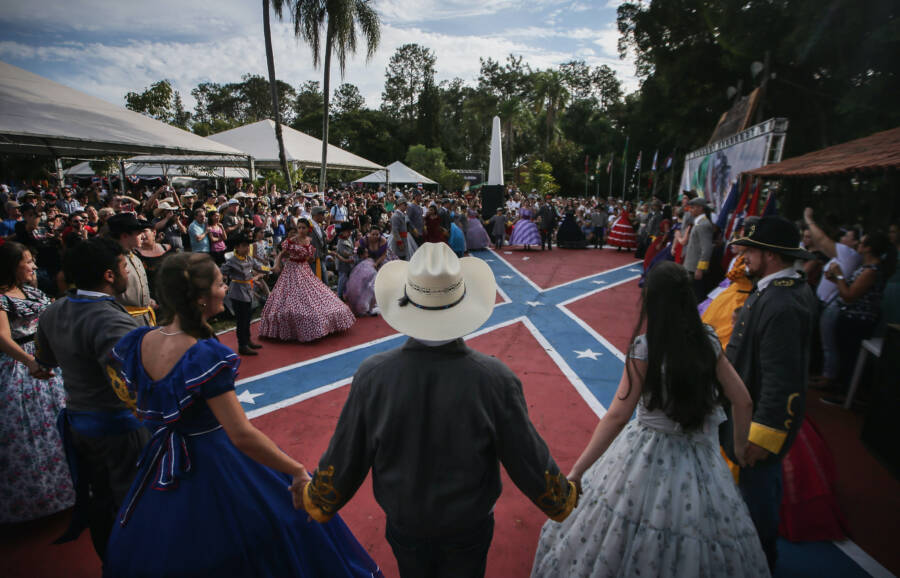
Mario Tama/Getty ImagesSanta Barbara d’Oeste, Brazil holds an annual Festa Confederada, or Confederate Party, like this one in 2016.
In April 1865, the American Civil War was over, and the former states of the Confederacy were in ruins. Astounding damage to infrastructure and the economy greeted Southern soldiers after the battle. As Confederate President Jefferson Davis languished in prison, his former cabinet members dispersed to their homes in defeat.
For die-hard Confederate loyalists like Col. William Hutchinson Norris and Maj. Lansford Hastings, this burden was too great. They couldn’t bear to live under what they saw as a foreign occupation, and decided instead to leave for the slaveholding Empire of Brazil and establish colonies of Confederados, Brazil’s odd Southern holdouts.
About 10,000 to 20,000 former Confederates followed them.
The Confederate Exodus
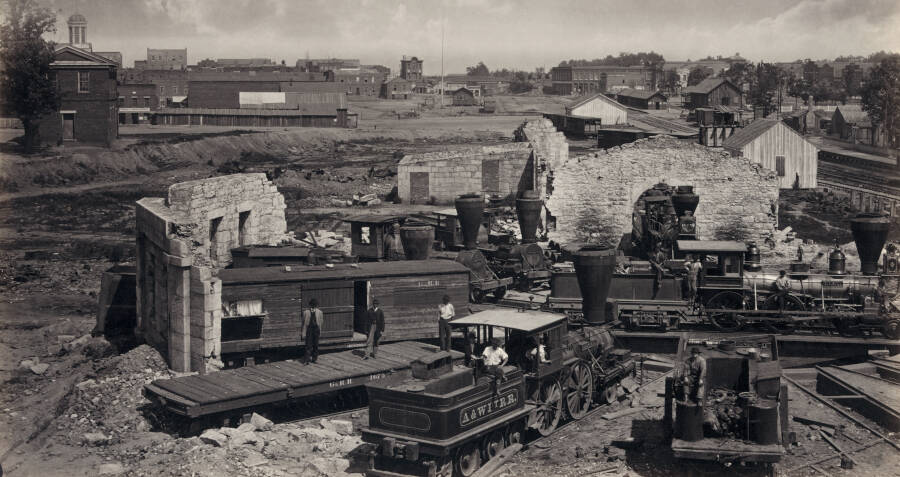
Wikimedia CommonsThe ruins of Atlanta’s rail depot were typical of the destruction that spurred many Confederados to emigrate.
Jefferson Davis and Robert E. Lee had urged Southerners to stay in the former states of the Confederacy and rebuild it, but those who were too proud to accept defeat, or whose land had been confiscated by federal authorities, felt they had little choice but to start over again abroad.
Popular destinations included Honduras, Mexico, and even Egypt, where former Confederate officers were invited to take up military commissions.
But for steady believers in white supremacy, only Brazil could offer them the haven they sought.

Wikimedia CommonsBrazilian emperor Dom Pedro II encouraged the settlement of the Confederados even as he worked to abolish slavery in his empire.
He had offered safe harbors to Confederate ships during the war, and despite his personal opposition to slavery, had no qualms about inviting slaveholding rebel refugees to Brazil to cultivate cotton and help modernize Brazilian agriculture.
Taking out advertisements in newspapers across the former Confederacy, he countered the sober advice of the captive Davis and the defeated Lee by painting a picture of a wild and bountiful country ripe for settlement and friendly to slavery. To former Confederates, Dom Pedro offered subsidized transportation to Brazil and land available for as little as 22 cents per acre.
Thousands of Southerners were hooked. They immediately sold off their possessions and began to make their way to Dom Pedro’s realm.
William H. Norris, Founding Father Of The Confederados

Wikimedia CommonsCol. William Hutchinson Norris founded the sole surviving Confederado settlement in Brazil.
Col. William H. Norris was one of the most prominent men who led efforts to settle beyond the reach of the victorious Union. A former state senator from Dallas County, Alabama, a grand master of the masonic Grand Lodge in Alabama, and a veteran of the Mexican-American War, Norris decided that a free United States was no place for his family.
After securing a small fortune in gold kept safe in a hole in his yard throughout the war (according to legend, Norris’s wife had kept Union soldiers from stealing the gold by sharing a secret Masonic handshake with their commanding officer), Col. Norris and his son Robert arrived in São Paulo state in southeastern Brazil in December 1865.
The Norrises purchased
three slaves and 500 acres of land near Santa Bárbara d’Oeste. By April 1866, their families had also made the journey. William and Robert then began a letter-writing campaign urging their friends and former neighbors to join them.
Within a few years, more than half a dozen Confederate settlements were established in the states of Pará, Paraná, and São Paulo.
Maj. Lansford Hastings spread word of the Confederate outposts in Brazil. Hastings, an explorer whose guidance had led to
the disastrous Donner Party incident, published
The Emigrant’s Guide to Brazil in 1867, a sensational travel book that promised unlimited wealth to those Southerners brave enough to strike out for themselves in Dom Pedro’s empire.
As the United States moved on from the horror of the Civil War, the unreformed Confederados, as local Brazilians called them, made every effort to preserve the illusion of life as it had been.
They practiced Protestant Christianity, cooked Southern food, spoke English, and fiercely resisted the temptation to blend into the local population, steadfastly keeping themselves separate and distinct.
The Confederados Try, And Fail, To Revive Their Dreams Of Slavery
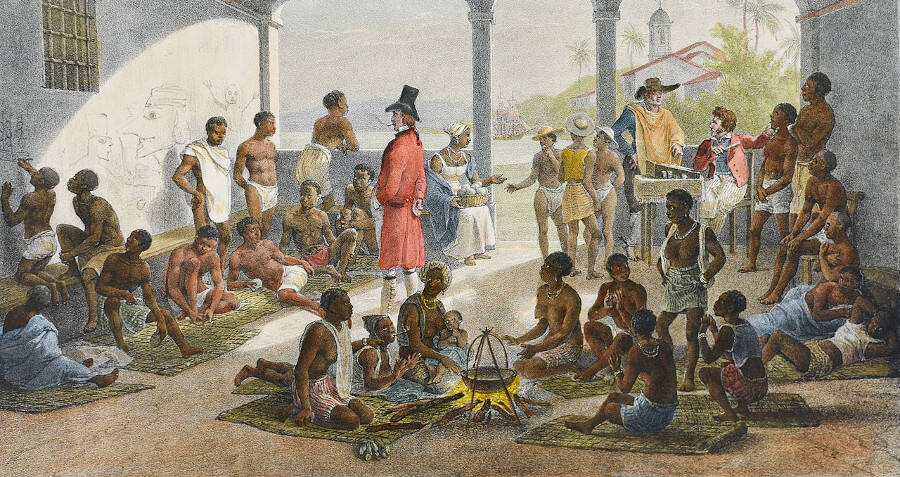
Wikimedia CommonsSlaves made up nearly half of the population of Brazil in the 19th century, attracting Southerners who sought to carry on the exploitation of slave labor.
From the beginning, the success and endurance of the Southerners’ colonies hinged on their ability to purchase and control slaves.
The South and Brazil had long held slavery in common. In fact, by the mid-19th century,
more than 40 percent of the victims of the Atlantic slave trade had ended up in the vast sugarcane fields of Brazil, where the fruit of their labors was gathered to sweeten coffee and tea in houses and cafés across Europe and North America.
But even though Southern emigrants arrived in Brazil with the patronage of the emperor, they succeeded in buying very few slaves. The Confederados spoke little Portuguese, and with insufficient funds and no personal connections in Brazil, they failed to purchase enough human lives to succeed in resurrecting the plantation agriculture system.
The End Of The Confederado Settlements
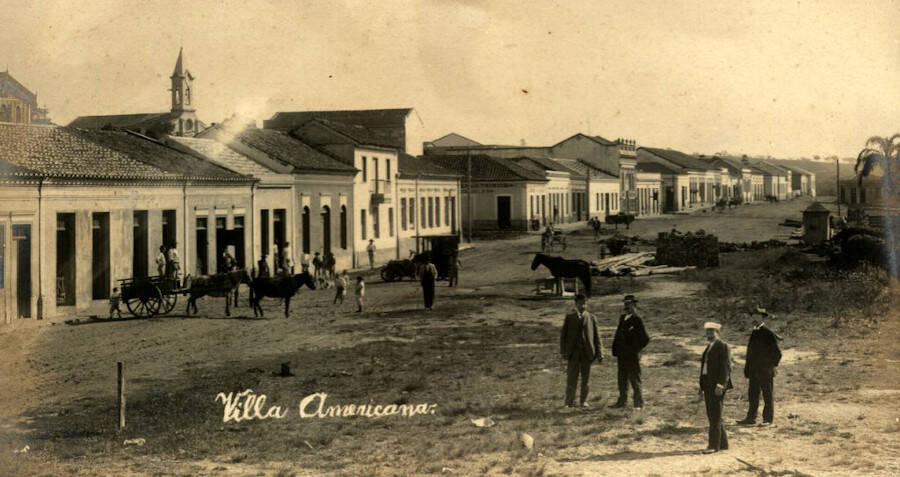
Wikimedia CommonsNorris’s Villa Americana in 1906
As the heads of individual colonies failed financially or died from disease, their followers drifted to other colonies, especially Norris’s Villa Americana in São Paulo. But perhaps the most significant reason for the failure of the Confederate diaspora was the failure of the
Reconstruction.
With federal authorities out of the way, Jim Crow began as Southern politicians regained their power and exacted revenge for their humiliation on their former slaves. To many struggling Confederados, this was more than they could have hoped for: the restoration of racist supremacy in the South.
It’s unknown how many exiled Southerners returned home in the years that followed. What is known is that many of the former settlements disbanded, and many either joined larger colonies or returned to a South eager to welcome them back. Those who remained became all the more close, intent on protecting their heritage even after Brazil abolished slavery in 1888.
The Legacy Of The Confederados
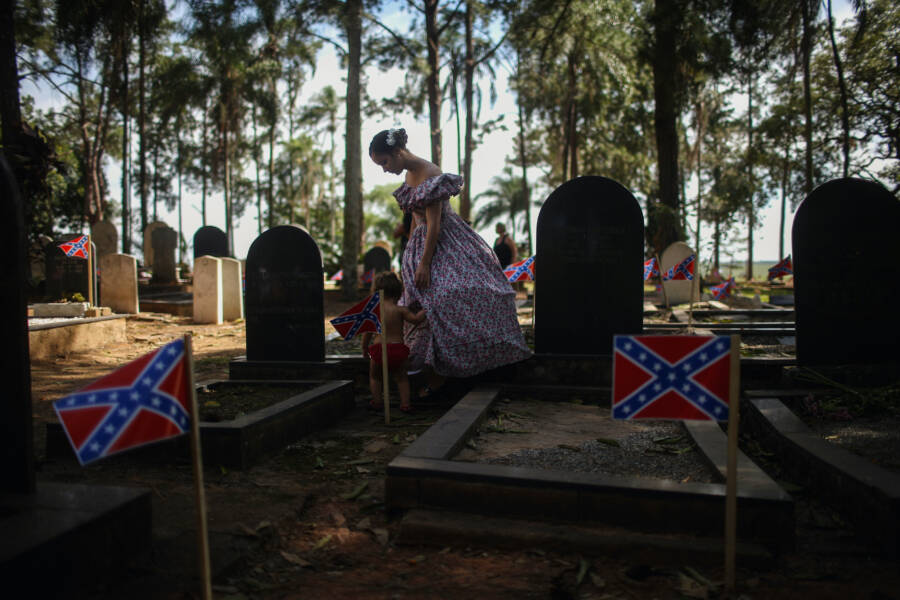
Mario Tama/Getty ImagesA woman dressed in a traditional hoop skirt walks past graves marked with Confederate flags in the American Cemetery during the annual Festa Confederada in 2016.
Although the 10,000 to 20,000 Confederados failed to build their longed-for Confederate holdout, they nevertheless left a deep and lasting impression in the country they helped settle, with their contributions seen for years afterward in agriculture, technology, and society.
Many of their descendants claimed that Brazil would have stagnated without their help, and while this isn’t exactly true, they did help speed up the adoption of technologies and innovations that were arriving on Brazil’s shores, such as
the metal-tipped plow and railroads.
It’s likely that Norris’s Villa Americana would have failed just as the other Confederado settlements did if not for the presence of one of Brazil’s earliest and most important railroads nearby, allowing the settlers to export their cotton and helping the country turn into a world leader in textile production.
In the years following their arrival, the Confederados were soon dwarfed by massive waves of immigrants from Germany, Italy, and Japan, each bringing their own contributions and leaving even more obvious impressions on Brazil as it developed into one of the most successful countries in South America.
But even today, as their numbers dwindle and their descendants speak more Portuguese and identify as Brazilian, the Confederados gather each year to celebrate their ancestry.
Dressed in antebellum hoop skirts and Confederate uniforms, they eat Southern food, dance to pre-war music, and fly the flag of the defeated South in a tribute to one of the strangest emigrations ever to take place in the Americas.









No comments:
Post a Comment
Note: Only a member of this blog may post a comment.